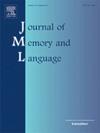Hierarchical prediction in toddlers: Semantic and phonological development
IF 3
1区 心理学
Q1 LINGUISTICS
引用次数: 0
Abstract
The predictive processing framework suggests that the brain generates semantic and phonological predictions to facilitate real-time language comprehension. While adults engage in both types of prediction, how these abilities develop in early childhood remains unclear. The present study explores the emergence of semantic and phonological predictions in toddlers aged 18, 24, and 30 months in three preferential looking experiments. Toddlers were presented with highly constrained sentence contexts paired with visual stimuli to assess their predictive abilities. Experiment 1 measured word prediction accuracy using predictable and unpredictable sentence conditions. Experiment 2 tested semantic prediction by introducing a semantic competitor, while Experiment 3 evaluated phonological prediction using phonologically similar competitors. Results showed that by 18 months, toddlers exhibited anticipatory looks toward the expected target. By 24 months, toddlers showed anticipatory looks toward not only the predictable target word but also toward semantically related items, and by 30 months, this pattern extended to phonologically related items. This developmental pattern—characterized by the earlier emergence of semantic relations followed by phonological relations—is consistent with the idea that semantic predictions provide a foundation for the subsequent development of phonological predictions. We discuss the data considering different prediction mechanisms, such as hierarchical predictive coding, prediction-by-production, and prediction through associations; we propose that these mechanisms are complementary components of a unified predictive system.
幼儿的等级预测:语义和语音发展
预测处理框架表明,大脑产生语义和语音预测,以促进实时语言理解。虽然成年人会进行这两种类型的预测,但这些能力在儿童早期是如何发展的尚不清楚。本研究通过对18个月、24个月和30个月学步儿童的偏好视觉实验,探讨了语义和语音预测的出现。研究人员向幼儿展示了高度受限的句子语境和视觉刺激,以评估他们的预测能力。实验1使用可预测和不可预测的句子条件来测量单词预测的准确性。实验2通过引入语义竞争对手来测试语义预测,而实验3使用音系相似的竞争对手来评估语音预测。结果表明,到18个月时,幼儿对预期目标表现出预期性的目光。到24个月时,幼儿不仅对可预测的目标单词表现出预期的目光,而且对语义相关的项目也表现出预期的目光,到30个月时,这种模式扩展到语音相关的项目。这种发展模式的特点是语义关系的早期出现,随后是语音关系的出现,这与语义预测为后续语音预测的发展提供基础的观点是一致的。我们讨论了考虑不同预测机制的数据,如分层预测编码、生产预测和关联预测;我们认为这些机制是一个统一的预测系统的互补组成部分。
本文章由计算机程序翻译,如有差异,请以英文原文为准。
求助全文
约1分钟内获得全文
求助全文
来源期刊
CiteScore
8.70
自引率
14.00%
发文量
49
审稿时长
12.7 weeks
期刊介绍:
Articles in the Journal of Memory and Language contribute to the formulation of scientific issues and theories in the areas of memory, language comprehension and production, and cognitive processes. Special emphasis is given to research articles that provide new theoretical insights based on a carefully laid empirical foundation. The journal generally favors articles that provide multiple experiments. In addition, significant theoretical papers without new experimental findings may be published.
The Journal of Memory and Language is a valuable tool for cognitive scientists, including psychologists, linguists, and others interested in memory and learning, language, reading, and speech.
Research Areas include:
• Topics that illuminate aspects of memory or language processing
• Linguistics
• Neuropsychology.

 求助内容:
求助内容: 应助结果提醒方式:
应助结果提醒方式:


